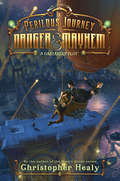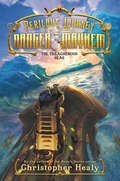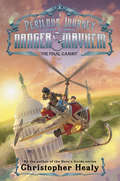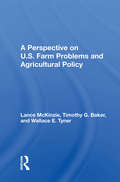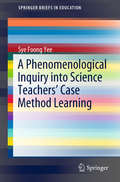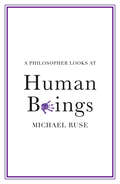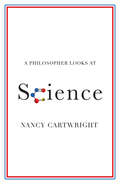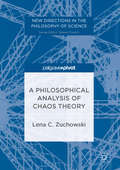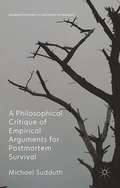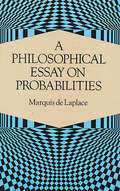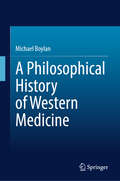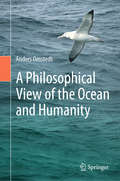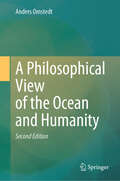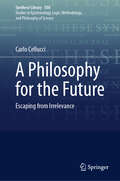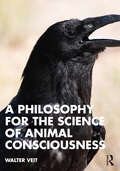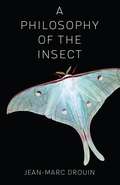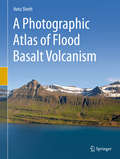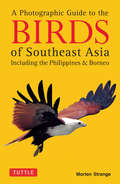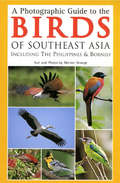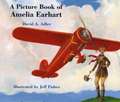- Table View
- List View
A Perilous Journey of Danger and Mayhem #1: A Dastardly Plot (Perilous Journey of Danger and Mayhem #1)
by Christopher HealyA rip-roaring, hilarious alternate-history adventure starring the world’s most famous inventors—and its most forgotten. From the author of the beloved Hero’s Guide series, Christopher Healy.It's 1883—the Age of Invention! A time when great men like Thomas Edison, Alexander Graham Bell, Nicola Tesla, and George Eastman work to turn the country into a land of limitless opportunity.And it all happens at the world famous Inventor’s Guild headquarters in New York City—a place where a great idea, a lot of hard work, and a little bit of luck can find you rubbing elbows with these gods of industry who will usher humanity into the future.Unless, of course, you’re a woman.Molly Pepper, daughter of brilliant but unknown inventor Cassandra Pepper, lives with her mother in New York. By day, they make ends meet running a pickle shop; but by night, they toil and dream of Cassandra taking her place among the most famous inventors in America.In an attempt to find a way to exhibit Cass’s work at the World’s Fair, they break into the Inventor's Guild, where they discover a mysterious plot to destroy New York.The evidence points to the involvement of one of the world’s most famous inventors, and now it’s up to Molly, Cassandra, and a shop hand named Emmett Lee to uncover the truth—even if no one will ever know it was they who did it.“Christopher Healy, author of the Hero’s Guide series, knows how to tell a good story. He’s done it again with the adventures of a determined girl named Molly Pepper.”—Brightly, Best Middle Grade Books of Fall 2018
A Perilous Journey of Danger and Mayhem #2: The Treacherous Seas (Perilous Journey of Danger and Mayhem #2)
by Christopher HealyThe second book in the new adventure trilogy from the beloved author of The Hero's Guide to Saving Your Kingdom.It's 1883—only a few months after Molly Pepper; her mother, Cassandra; and her friend, Emmett, saved New York from an attack by the megalomaniacal Ambrose Rector while managing to preserve the reputations of Alexander Graham Bell and Thomas Edison, whose technology was manipulated in Rector’s scheme. Their selfless heroism will finally earn them a place in the Inventors’ Guild, alongside the greatest minds of their generation.Unless, of course, no one knows that they did any of that.Left with nothing but empty promises and a struggling pickle shop after the government chooses to cover up the crisis, Molly, Cassandra, and Emmett have no idea where to turn—until they learn of a daring expedition to the South Pole, where an meteorite of mysterious power is embedded, and where Emmett’s father, explorer and ship captain Wendell Lee, disappeared years ago. With the fate of the world hanging in the balance, our heroes commandeer an experimental seacraft to make their play on the pole. But the trip is more treacherous than they realize, and there’s no guarantee that they will return successful—if they even return at all.
A Perilous Journey of Danger and Mayhem #3: The Final Gambit (Perilous Journey of Danger and Mayhem #3)
by Christopher HealyThe thrilling conclusion to Christopher Healy's funny, action-packed, acclaimed alt-history adventure!It is 1884, and Molly and Cassandra Pepper, Emmett Lee, and Emmett’s long-lost father are sailing back to New York following their death-defying adventure in Antarctica. Having discovered a subterranean world at the South Pole while saving the world from certain doom once again, surely their accomplishments will finally earn them the recognition they deserve.Unless, of course . . . well, you know by now.And so do the Peppers and Lees. They’re used to having their deeds covered up by the government in order to protect powerful men, and frankly, they’re sick of it. And when their return to New York doesn’t go the way they’d planned, they decide that maybe it’s best to go into hiding and accept that, perhaps, the forces aligned against them are just too great.As the 1884 presidential election approaches, however, our heroes discover a plot against leading candidate Thomas Edison that only they can stop. It’ll be up to them to decide whether to come out of hiding, make the perilous journey to Washington, DC, and do the right thing one last time. Even if it means risking everything they have left.
A Perspective On U.s. Farm Problems And Agricultural Policy
by Lance McKinzieA Perspective on U.S. Farm Problems and Agricultural Policy provides a framework for evaluating national policy alternatives and attempts to improve our understanding of the nature of U.S. farm sector and its problems.
A Phenomenological Inquiry into Science Teachers’ Case Method Learning (SpringerBriefs in Education)
by Sye Foong YeeThis book illustrates a practical application of the Case Method as a teaching technique in teacher education, and examines how learning takes place in a teacher professional development activity. It also describes teachers’ lived experience of the activity based on Clark Moustakas' 1994 guidelines for organizing and presenting a phenomenological study.
A Phenomenological Revision of E. E. Harris's Dialectical Holism
by James SchofieldThe purpose of this work is to critically assess Errol E. Harris’s process philosophy in the face of contemporary research in the special sciences. Harris devoted his life to grappling with the big questions concerning the relationships between nature, mind, and knowledge. His 70-plus year career was distinguished, his texts on the history of philosophy, philosophy of science, political philosophy, philosophy of religion, and consciousness were widely published, and yet his metaphysics has until now remained excluded from mainstream discussions. This book’s contention is that Harris’s work reveals as yet unnoticed connections between theories in numerous scientific disciplines ranging from psychology to cosmology and that an examination of certain theories within these disciplines may serve to strengthen his original arguments. This work maintains that the resulting metaphysics frames a transdisciplinary paradigm shift and provides a viable solution to the hard problem of consciousness.
A Philosopher Looks at Human Beings (A Philosopher Looks At)
by Michael RuseWhy do we think ourselves superior to all other animals? Are we right to think so? In this book, Michael Ruse explores these questions in religion, science and philosophy. Some people think that the world is an organism - and that humans, as its highest part, have a natural value (this view appeals particularly to people of religion). Others think that the world is a machine - and that we therefore have responsibility for making our own value judgements (including judgements about ourselves). Ruse provides a compelling analysis of these two rival views and the age-old conflict between them. In a wide-ranging and fascinating discussion, he draws on Darwinism and existentialism to argue that only the view that the world is a machine does justice to our humanity. This new series offers short and personal perspectives by expert thinkers on topics that we all encounter in our everyday lives.
A Philosopher Looks at Science
by Nancy CartwrightWhat is science and what can it do? Nancy Cartwright here takes issue with three common images of science: that it amounts to the combination of theory and experiment; that all science is basically reducible to physics; and that science and the natural world which it pictures are deterministic. The author's innovative and thoughtful book draws on examples from the physical, life, and social sciences alike, and focuses on all the products of science – not just experiments or theories – and how they work together. She reveals just what it is that makes science ultimately reliable, and how this reliability is nevertheless still compatible with a view of nature as more responsive to human change than we might think. Her book is a call for greater intellectual humility by and within scientific institutions. It will have strong appeal to anyone who thinks about science and how it is practised in society.
A Philosophical Analysis of Chaos Theory
by Lena C. ZuchowskiThis book provides an analysis of the construction, diagnosis (as chaotic) and evaluation of models in chaos theory. It contains a detailed look at the interaction of the different models used in chaos theory and analyses how these models influence the way chaos is defined. Furthermore, the book discusses the conditions for the occurrence of chaos and the detection of chaos in nature.
A Philosophical Approach to MOND: Assessing the Milgromian Research Program in Cosmology
by David MerrittDark matter is a fundamental component of the standard cosmological model, but in spite of four decades of increasingly sensitive searches, no-one has yet detected a single dark-matter particle in the laboratory. An alternative cosmological paradigm exists: MOND (MOdified Newtonian Dynamics). Observations explained in the standard model by postulating dark matter are described in MOND by proposing a modification of Newton's laws of motion. Both MOND and the standard model have had successes and failures – but only MOND has repeatedly predicted observational facts in advance of their discovery. In this volume, David Merritt outlines why such predictions are considered by many philosophers of science to be the 'gold standard' when it comes to judging a theory's validity. In a world where the standard model receives most attention, the author applies criteria from the philosophy of science to assess, in a systematic way, the viability of this alternative cosmological paradigm.
A Philosophical Approach to Quantum Field Theory
by Hans Christian ÖttingerThis text presents an intuitive and robust mathematical image of fundamental particle physics based on a novel approach to quantum field theory, which is guided by four carefully motivated metaphysical postulates. In particular, the book explores a dissipative approach to quantum field theory, which is illustrated for scalar field theory and quantum electrodynamics, and proposes an attractive explanation of the Planck scale in quantum gravity. Offering a radically new perspective on this topic, the book focuses on the conceptual foundations of quantum field theory and ontological questions. It also suggests a new stochastic simulation technique in quantum field theory which is complementary to existing ones. Encouraging rigor in a field containing many mathematical subtleties and pitfalls this text is a helpful companion for students of physics and philosophers interested in quantum field theory, and it allows readers to gain an intuitive rather than a formal understanding. Applies philosophical ideas to develop a new and unique perspective on various approaches to quantum field theory. Challenges and supports the reader in recognizing the conceptual foundations of quantum field theory. Formulates quantum field theory in the setting of irreversible dynamics to account for particle creation and annihilation processes that are completely beyond our control.
A Philosophical Critique of Empirical Arguments for Postmortem Survival (Palgrave Frontiers in Philosophy of Religion)
by Michael SudduthSudduth provides a critical exploration of classical empirical arguments for survival arguments that purport to show that data collected from ostensibly paranormal phenomena constitute good evidence for the survival of the self after death. Utilizing the conceptual tools of formal epistemology, he argues that classical arguments are unsuccessful.
A Philosophical Essay on Probabilities
by Marquis De LaplaceThis classic introduces the concepts and uses of probability theory. It demonstrates, without the use of higher mathematics, the application of probability to games of chance, physics, reliability of witnesses, astronomy, insurance, democratic government, and many other areas. It also shows how scientists can express complex ideas in simple terms.
A Philosophical History of Western Medicine
by Michael BoylanThis book provides an historical and philosophical overview of Western medicine along with commentary about how past principles affect current problems in biomedicine like genetic engineering, transhumanism, and a commitment to environmentalism. The book spans Ancient, Hippocratic and Galenic texts, Medieval writings, Modern contributions, and contemporary discoveries in the history and philosophy of medicine, including the growing role of technology in the practice of medicine. This book is of essential reading material for scholars and students interested in the history and philosophy of science as it relates to medicine, as well as those interested in the normative consequences of the study of nature for our contemporary world, particularly as it relates to medicine, environmental ethics, and genetic engineering.
A Philosophical View of the Ocean and Humanity (Springerbriefs In Environmental Science Ser.)
by Anders OmstedtThis book is about the ocean and about the future. It is written in two modes, a concerned analytical scientific mode and an intuitive artistic mode in which the ocean is given a voice. The disconnect in the relationship between human dependency on and feelings about the ocean is examined in a dialogue between these two modes. The book illustrates how science and the arts can be connected to increase our awareness of the state of the ocean and support behavioural change. This book is intended for everyone who would like to contribute to the sustainable use of the ocean. Includes forewords by Alice Newton, University of Algarve, Portugal and Martin Visbeck, GEOMAR, Helmholtz Centre for Ocean Research, Kiel, Germany.
A Philosophical View of the Ocean and Humanity: Second Edition
by Anders OmstedtThis book provides an overview of major threats to our blue planet. But also tools for connecting facts and values to change our often destructive behavior towards nature. The solutions to achieving an ocean in harmony with man are within us, where compassion, curiosity, empathy, courage, and creativity are needed for sustainable change. Therefore, with this book, I want to arouse your curiosity and give the reader, the courage to face the future better by introducing tools for deep diving into our outer and inner world with many hidden resources. The book brings the reader into humans' challenges with the ocean and its future. It addresses some of the main questions in the United Nations Ocean Decade initiative that aims to change how humans deal with the ocean. This unique book will stimulate a broad way of thinking by connecting analytical science thinking and intuition. In the book's first part, art and dreams are used to connect science and art. This knowledge is then applied in part II of the book, written in two modes: a concerned science mode and an intuitive, artistic mode in which the ocean is given a voice. Part III illustrates how science and art can be connected to increase our awareness of the state of the ocean and support behavioral change.
A Philosophy for the Future: Escaping from Irrelevance (Synthese Library #508)
by Carlo CellucciThis book offers an alternative to the present prevailing approach to philosophy. For, there have never been so many professional philosophers as there are today, yet philosophy has never been so irrelevant. This is because according to today&’s dominant philosophy, namely analytic philosophy, philosophy does not advance knowledge, but only aims to understand what we already know. As a result, philosophy deals with artifactual puzzles of no abiding significance. This contrasts with the fact that, at some stages of its historical development, philosophy has played a significant role in the advancement of knowledge. To overcome the present impasse of philosophy, this book proposes a view of philosophy as acquisition of knowledge, according to which philosophy can open new ways to knowledge and lead to the birth of new sciences.
A Philosophy for the Science of Animal Consciousness
by Walter VeitThis book attempts to advance Donald Griffin's vision of the "final, crowning chapter of the Darwinian revolution" by developing a philosophy for the science of animal consciousness. It advocates a Darwinian bottom-up approach that treats consciousness as a complex, evolved, and multidimensional phenomenon in nature rather than a mysterious all-or-nothing property immune to the tools of science and restricted to a single species. The so-called emergence of a science of consciousness in the 1990s has at best been a science of human consciousness. This book aims to advance a true Darwinian science of consciousness in which its evolutionary origin, function, and phylogenetic diversity are moved from the field’s periphery to its very centre, thus enabling us to integrate consciousness into an evolutionary view of life. Accordingly, this book has two objectives: (i) to argue for the need and possibility of an evolutionary bottom-up approach that addresses the problem of consciousness in terms of the evolutionary origins of a new ecological lifestyle that made consciousness worth having and (ii) to articulate a thesis and beginnings of a theory of the place of consciousness as a complex evolved phenomenon in nature that can help us to answer the question of what it is like to be a bat, an octopus, or a crow. A Philosophy for the Science of Animal Consciousness will appeal to researchers and advanced students interested in advancing our understanding of animal minds as well as anyone with a keen interest in how we can develop a science of animal consciousness.
A Philosophy of the Insect
by Jean-Marc DrouinThe world of insects is at once beneath our feet and unfathomably alien. Small and innumerable, insects surround and disrupt us even as we scarcely pay them any mind. Insects confront us with the limits of what is imaginable, while at the same time being essential to the everyday functioning of all terrestrial ecosystems.In this book, the philosopher and historian of science Jean-Marc Drouin contends that insects pose a fundamental challenge to philosophy. Exploring the questions of what insects are and what scientific, aesthetic, ethical, and historical relationships they have with humanity, he argues that they force us to reconsider our ideas of the animal and the social. He traces the role that insects have played in language, mythology, literature, entomology, sociobiology, and taxonomy over the centuries. Drouin emphasizes the links between humanistic and scientific approaches—how we have projected human roles onto insects and seen ourselves in insect form. Caught between the animal and plant kingdoms, insects force us to confront and reevaluate our notions of gender, family, society, struggle, the division of labor, social organization, and individual and collective intelligence. A remarkably original and thought-provoking work, A Philosophy of the Insect is an important book for animal studies, environmental ethics, and the history and philosophy of science.
A Photographic Atlas of Flood Basalt Volcanism
by Hetu ShethThis unique book presents hundreds of spectacular photographs of large-scale to small-scale field geological features of flood basalt volcanism from around the world. Major flood basalt provinces covered in this book include the British Palaeogene, Central Atlantic Magmatic Province, Columbia River, Deccan, East Greenland, Emeishan, Ethiopian, Ferrar-Karoo-Tasmania, Iceland, Indo-Madagascar, Paran#65533;, Siberian, West Greenland, and others. Intermediate- to small-sized flood basalts (such as Saudi Arabia and South Caucasus) are also included. Different chapters of the book illustrate varied features of flood basalts, including landscapes, lava flow morphology and stacking, structures formed during lava flow transport, inflation and degassing, structures produced during lava solidification, subaqueous volcanism and volcanosedimentary associations, explosive volcanism, intrusions, igneous processes and magmatic diversity, tectonic deformation, secondary mineralization, and weathering and erosion. This book will be valuable for a large audience: specialists studying flood basalt volcanology, petrology, geochemistry, geochronology, geophysics, and environmental impact and mass extinction links; nonspecialists who want to know more about flood basalts; field geologists (such as those working in geological surveys); students of volcanology and igneous petrology, and even people employed in the industry, such as those working on flood basalt-hosted groundwater or petroleum reservoirs.
A Photographic Guide to the Birds of Southeast Asia
by Morten StrangeA Photographic Guide to the Birds of Southeast Asia is the first comprehensive photographic guide to the birds of mainland Southeast Asia, the Philippines and Borneo. It covers important bird species found in Malaysia, Singapore, Thailand, Cambodia and Vietnam, as well as southern China, Hong Kong, Taiwan and the Philippines.Of an estimated 10,000 living bird species in the world, Southeast Asia is home to over 3,000 of them-making this one of the most diverse avifaunal regions on the planet and a bird-watcher's paradise. This comprehensive guide covers over 660 species and has more than 700 color photographs. It is an invaluable guide to anyone planning a visit to Asia who is interested in birds. It gives a distribution map for each species and a checklist at the back.Many of the photographs in this book appear for the first time and have been carefully selected to illustrate the most important species and their key features. The text provides vital information to ensure accurate identifications. A Photographic Guide to the Birds of Southeast Asia is indispensable reading for bird lovers everywhere.
A Photographic Guide to the Birds of Southeast Asia
by Morten StrangePeriplus is proud to present the very first comprehensive photographic guide to the birds of mainland Southeast Asia, the Philippines and Borneo. Included are the birds of Peninsular Malaysia, Thailand and Indochina, as well as those found in South China, Hong Kong and Taiwan.This book covers 668 species and contains more than 700 color photographs. There is a distribution map for each species.Many of the photographs in this magnificent volume appear for the first time and have been carefully selected to show the most important species. The concise text provides vital information that will ensure accurate identification of species in one of the most diverse avifauna regions. Indispensable reading for all bird lovers.
A Picture Book Of Thomas Alva Edison
by David A. Adler Alexandra Wallner John WallnerAn introduction to the genius with a curious mind who loved to experiment and who invented the phonograph, light bulb, movie camera, and numerous other items.
A Picture Book of Amelia Earhart
by David A. AdlerDiscusses the life of the pilot who was the first woman to cross the Atlantic by herself in a plane.
A Picture Book of Benjamin Franklin (Picture Book Biography)
by David A. AdlerWriter, printer, scientist, inventor, statesman, and youngest son in a family of seventeen children, Benjamin Franklin is considered one of our greatest Americans.Supported by colorful illustrations, Adler's biography brings to life one of America's founding fathers, Benjamin Franklin. Adler highlights Franklin's stunning accomplishments and his day-to-day life from his time as a young boy in Boston, Massachusetts through his role as the oldest delegate to the Constitutional Congress at the age of 81.A lifelong book lover and printer, Franklin poularized famous sayings like "haste makes waste" and "early to bed, early to rise, makes a man healthy, wealthy, and wise" in his annual Poor Richard's Almanack. An energetic inventor and public servant, he created the Franklin stove and bifocal glasses and established the first lending library and hospital in America.Young readers looking for insight into one of America's greatest founders, will find inspiration while gaining understanding and appreciation of US colonial history.
